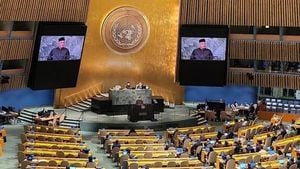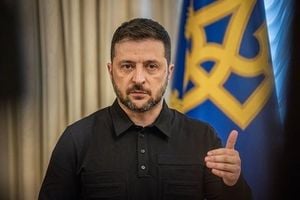For the third day in a row, the streets of Antananarivo, Madagascar’s bustling capital, have echoed with the chants and songs of thousands of young protesters. The cause: chronic water and electricity outages that have upended daily life and brought simmering frustrations to a boil. On Monday, September 29, 2025, those frustrations boiled over, with police firing tear gas at crowds that refused to disperse—a dramatic escalation in what has become the largest wave of demonstrations the Indian Ocean island has seen in years.
According to AP and StratNews Global, these youth-led protests, inspired by recent “Gen Z” movements in Kenya and Nepal, represent the most serious challenge to President Andry Rajoelina’s authority since his re-election in 2023. The demonstrators, many of them university students, gathered at campuses waving placards and singing the national anthem, before attempting to march through the city. Their demands were clear: the resignation of Prime Minister Christian Ntsay, his government, and Rajoelina himself. Some carried flags adapted from Nepal’s recent protest movement, while others donned T-shirts emblazoned with a cartoon skull and bones from the Japanese anime series “One Piece”—a symbol that has come to represent youthful defiance across parts of Asia and Africa.
The unrest began on Thursday, September 25, 2025, when the first crowds took to the streets to protest the government’s failure to provide reliable water and electricity. The outages have been especially acute in Antananarivo, where even newly built public works—such as the city’s cable car system—operate only a few hours a day, powered by generators. By Thursday night, authorities had declared a dusk-to-dawn curfew in the capital, and by Friday, that curfew had spread to other major cities. But the restrictions did little to quell the anger. Instead, the protests intensified, fueled by social media and a sense of solidarity with similar movements abroad.
As the days passed, the demonstrations grew larger and more confrontational. Protesters barricaded roads with rocks, burning tires, and even telephone poles. Police responded with tear gas, and, according to the United Nations human rights office, some security forces resorted to beatings, arrests, and even live ammunition. In a statement released Monday, the U.N. reported that 22 people had been killed and more than 100 injured in the clashes—a toll it blamed on a “violent response by security forces.” The U.N. high commissioner for human rights, Volker Turk, expressed shock at the scale and intensity of the crackdown, noting that the protests had begun peacefully but escalated after what he described as “unnecessary force” by authorities.
Not all of the violence, however, was directly linked to the protesters. The U.N. clarified that some deaths and injuries occurred during looting and vandalism by gangs unaffiliated with the main protest movement. In Antananarivo’s Anosibe neighborhood, for example, looting and property destruction were reported on Friday, September 26. Several stations of the city’s new cable car system were set ablaze, and local media documented attacks on the homes of politicians known to be close allies of President Rajoelina.
General Angelo Ravelonarivo, who heads a joint security body comprising police and military officials, addressed the nation on privately owned Real TV late Thursday. “There are unfortunately individuals taking advantage of the situation to destroy other people’s property,” he said, underscoring the government’s concern that the unrest could spiral further out of control.
By Monday, the situation had reached a critical point. In a dramatic move broadcast live on national television, President Rajoelina announced that he was firing Prime Minister Christian Ntsay and the entire government. However, he clarified that the outgoing officials would remain in place on an interim basis until a new government could be formed. Rajoelina invited applications for government positions and set a three-day deadline for proposals for a new prime minister. “Your demands have been heard, and I apologize if there are members of the government who have not done the work that the people expected,” he said, acknowledging the depth of public frustration but giving no indication that he himself would step down.
Rajoelina’s speech also included a rare admission of fault. “If there have been mistakes, I recognise them, and I am now looking for ways to correct everything,” he told residents of the Anosibe neighborhood, where some of the worst violence had occurred. He expressed sympathy for those who had lost loved ones in the protests, though he did not offer a specific death toll. Meanwhile, Madagascar’s foreign minister, Rasata Rafaravavitafika, disputed the U.N.’s figure of 22 deaths, stating that “the government strongly denies” that so many had died, but the authorities themselves did not provide alternative numbers.
Placards at the protests bore slogans such as “Justice for Madagascar,” “Leo” (meaning “we’re fed up” in Malagasy), and “We want to live, not just survive.” The anger on display was not just about utilities. According to the World Bank, urban poverty in Madagascar has been rising sharply in recent years. Many protesters see the chronic water and electricity shortages as emblematic of deeper governance problems and a lack of accountability from those in power.
President Rajoelina, 51, has a complicated political history. He first came to national prominence as the leader of a provisional government following a 2009 coup, and has served as president since 2019. His most recent re-election in 2023 was marred by controversy, with most opposition candidates boycotting the vote. That legitimacy gap has only widened during the current crisis, as the government’s inability to provide basic services has become a rallying point for a new generation of activists.
The protests in Madagascar are part of a broader wave of youth-led movements across Africa and Asia, where social media has become a powerful tool for organization and mobilization. In both Kenya and Nepal, similar tactics—online coordination, symbolic flags, and viral slogans—have been used to force governments to back down or even resign. In Madagascar, the adoption of these strategies and symbols has given the movement a sense of global solidarity, but also heightened the stakes for the government.
For now, Madagascar’s future remains uncertain. The government’s response—firing the cabinet, imposing curfews, and promising reform—has done little to satisfy the protesters, who continue to demand deeper change. As the world watches, the question is whether this new generation of activists will succeed in reshaping their country’s politics, or whether the cycle of protest and repression will continue.
What’s clear is that the voices of Madagascar’s youth, echoing from Antananarivo’s university campuses to its barricaded streets, have forced the nation’s leaders to listen—and the coming days will reveal just how far those leaders are willing to go to address the grievances that brought so many into the streets.




